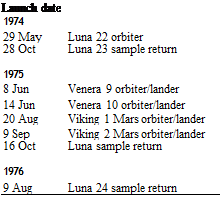Turning from the Moon and Mars to Venus
TIMELINE: 1974-1976
Afler abandoning its manned lunar program, the USSR continued to send robotic missions. In May 1974 they launched Luna 22, which became their second orbiter in the new heavy series. The Luna 23 sample return mission in October 1974 damaged its drill system on landing, which ruined the mission. A year later, another sample return mission was lost to a Block D failure. But Luna 24 launched in August 1976 became the third successful sample return. This drew to a conclusion the long line of missions which began with Luna 1 to 3, small 300 kg spacecraft that used the three-stage R-7 Luna launcher, then Luna 4 to 14, with 1,600 kg spacecraft that used the four-stage R-7 Molniya, and finished with Luna 15 to 24, with 5,800 kg spacecraft that used the four-stage Proton-K. There had been many failures but this series gave the Soviets the first lunar flyby, first lunar impact, first pictures of the far side of the Moon, first landing, first orbiter, first sample return, and first surface rover.
After the objectives of the direct-entry 3MV series at Venus were achieved by the landing of Venera 8 in 1972, the Soviets stood down during the 1973 opportunity in order to develop a spacecraft capable of both orbiting the planet and dispatching a larger and more capable lander equipped with imagers. They based the new Venera on the Proton-launched Mars spacecraft that proved itself in 1971. In June 1975 two were launched as Venera 9 and 10. They both performed spectacularly by releasing their entry systems inbound and then entering orbit around the planet. Furthermore, both landers yielded atmospheric data and survived on the surface for about an hour, from where they took the very first black-and-white pictures from the surface of the planet and returned data on the composition of the rocks.
W. T. Huntress and M. Y. Marov, Soviet Robots in the Solar System: Mission Technologies and Discoveries, Springer Praxis Hooks 1, DOl 10.1007/978-1-4419-7898-1 14,
© Springer Science+Business Media, LLC 2011
 |
 |
The US sent its two sophisticated Viking spacecraft to Mars in 1975. Both were highly successful, the orbiters as well as the landers. Reeling front the failure of their all-out assault on Mars in 1973 and the awesome performance of the Vikings, the Soviets abandoned their long and hapless campaign at Mars in favor of Venus. They would not develop the confidence to resume Mars missions until 1988. Meanwhile, their new Venera spacecraft delivered a long string of successes.










